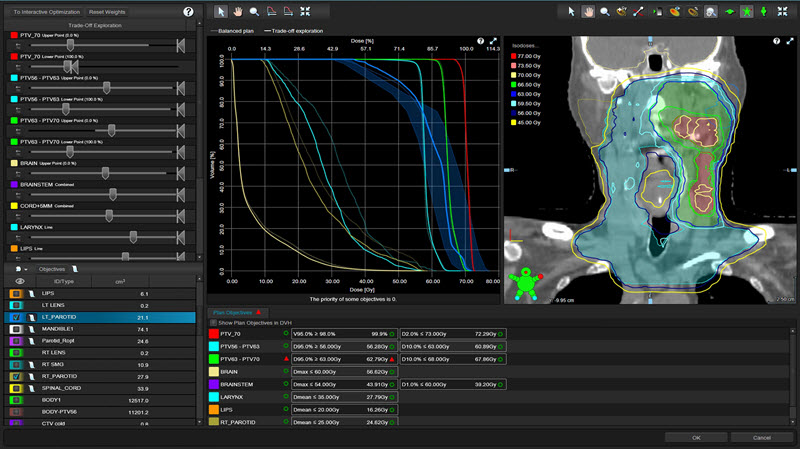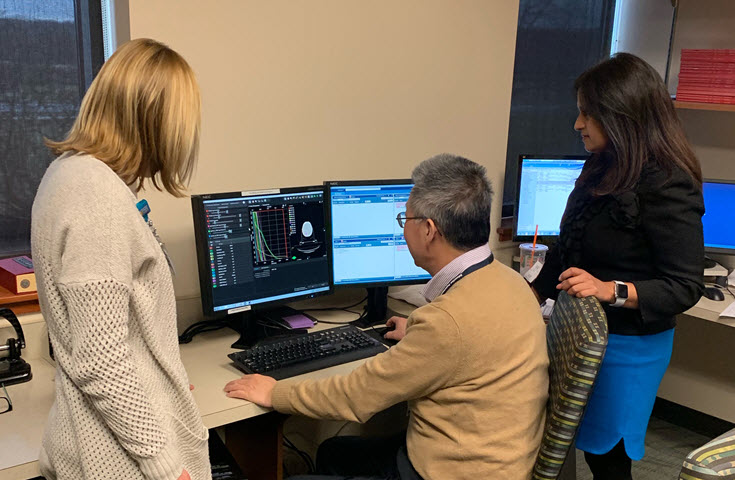Multi-criteria Optimization (MCO) is a clinical decision support tool that was added to Varian’s Eclipse™ treatment planning system in version 15.5. MCO enables clinicians to quickly improve plan quality by balancing clinical tradeoffs. Using this tool, clinicians can explore what happens when they vary different clinical criteria, such as the degree to which particular organs are spared versus coverage of the targeted tumor, without a time-consuming trial and error process.
“Manual treatment planning—especially for complex cases—can take a day or longer. With the MCO tool, we are creating high-quality plans for very challenging cases that we could not have achieved in the past—in a fraction of the time,” said Suzanne Currie, MSc, medical physicist and clinical scientific lead at the Beatson West of Scotland Cancer Centre in Glasgow, U.K. “And we are seeing a dramatic reduction in the radiation dose to organs at risk, sometimes as much as 20-30%, even as we are maintaining and often improving tumor coverage.”
“MCO is a very powerful and clinically beneficial tool that will take many of the inefficiencies out of treatment planning and provide the required information to dosimetrists and clinicians at the time they need it most,” stated Trent Aland, national director of Physics at Icon Group, Australia’s largest dedicated cancer care provider. Aland was among those who led preclinical testing of the MCO tool in Eclipse 15.5.
“MCO works by creating several optimized treatment plans that the user can visually review and evaluate using slider bars,” said Aland. “For example, if the clinician would like to explore possible compromises between doses to organs-at-risk and how these affect the target coverage, this is possible to achieve 'on the fly' without the need to re-optimize or re-calculate dose. This real-time exploration of trade-offs helps to eliminate the back-and-forth between dosimetrist and clinician, allowing for efficiency gains in the planning timeframe. We also see MCO as a tool to further improve and optimize RapidPlan™ models.”
 A screenshot from the MCO Workspace. By using the slider bars on the left, clinicians are able to investigate trade-offs between target coverage and organ sparing during treatment planning. Here they will see the impact of these trade-offs on the dose volume histograms, the 3D dataset and on their clinical goals.
A screenshot from the MCO Workspace. By using the slider bars on the left, clinicians are able to investigate trade-offs between target coverage and organ sparing during treatment planning. Here they will see the impact of these trade-offs on the dose volume histograms, the 3D dataset and on their clinical goals.
Developed by Mathematicians at Fraunhofer Institute for Industrial Mathematics
Using technology licensed from the Fraunhofer Institute for Industrial Mathematics (Fraunhofer ITWM) in Germany, the MCO tool in Eclipse was developed in collaboration with Dr. Karl-Heinz Kuefer, Division Director Optimization at Fraunhofer ITWM, and his team. Dr. Kuefer’s field is mathematics, and MCO was one of the topics he has been working on since his PhD thesis. “I began working on its application to radiotherapy in 1996 when a PhD student asked for my help in the mathematics of radiotherapy planning. Modeling treatment planning as a multi-criteria optimization problem, around the millennium we developed a real-time decision support tool that could evaluate all the best possible compromises between clinical tradeoffs —known as ‘Pareto-optimal solutions’— to enable clinicians to select the most appropriate treatment for a patient.”
Users Cite Gains in Planning Efficiency and Quality
Clinicians at four cancer centers of St. Luke’s University Health Network in Pennsylvania have been using MCO to optimize treatment planning since August 2018. Tianyou Xue, Ph.D., chief physicist at St. Luke’s, first saw Eclipse with MCO demonstrated at the July/August 2017 American Association of Physicists in Medicine (AAPM) Conference, and he was intrigued with how the tool could help users enhance the quality and efficiency of their planning process.
 A clinical team at St. Luke’s University Health Network evaluate trade-offs in a treatment plan using multi-criteria optimization.
A clinical team at St. Luke’s University Health Network evaluate trade-offs in a treatment plan using multi-criteria optimization.
“We were one of the first Varian MCO users,” remarked Dr. Xue, “and we’ve been impressed with how much MCO has improved the optimization of IMRT and VMAT plans. Most optimization methods require many iterations of plans, which is time-consuming. Conversely, MCO runs in the background on Eclipse and gives us a group of optimized plans for exploring the tradeoffs as we vary different parameters. Using MCO, we’ve been able to improve our optimization process, creating higher-quality plans in less time.”
“We are finding great gains in speed and efficiency by utilizing MCO,” stated Jennifer Jones, CMD, RT(R)(T), lead dosimetrist at St. Luke’s University Health Network. “This is especially true for more complicated cases, such as partial brain, head and neck, and lung. For example, with the use of MCO we are able to make adjustments to complicated cases by evaluating changes to the target volume as we adjust the dose to adjacent critical structures without having to run multiple iterations of the plan.”
According to Dr. Xue, his team devoted some time to developing proficiency with the MCO tool. “When we first started using MCO, we wanted to reduce the dose to OARs, but we pushed too hard and this resulted in hot spots inside the planning target volume,” he remarked. “However, the MCO tool is easy to use so we quickly learned how to balance target coverage with sparing healthy tissue, to create excellent plans for our patients.”
Dramatic Reductions in Dose to OARs
Clinicians at the Beatson West of Scotland Cancer Center in Glasgow, U.K., also note how MCO has improved the quality of their planning across a wide range of treatment sites.
“We had seen MCO at an early stage, so we were aware of its potential,” said Garry Currie, head of radiotherapy physics at Beatson. In September 2018, shortly after Eclipse 15.5 with MCO was installed, the clinical team found itself struggling to create a quality treatment plan for a patient with gynecological cancer.
“We were having difficulty reducing the dose to OARs, specifically the bladder and rectum,” Garry Currie noted. “We were pleasantly surprised with how successfully we were able to reduce the dose to these organs using MCO. In fact, we are consistently seeing dramatic reductions in the dose to OARs—sometimes as much as 30%—depending on the plan.”
Like their counterparts at St. Luke’s, the team at Beatson is also seeing significant improvements in their complicated cases. This is especially true for pediatric cases and plans involving the central nervous system. “The most significant reductions in dose to OARs have been for our younger patients, for example, where we are trying to treat the whole lung while reducing the dose to the heart,” noted Suzanne Currie. “Using MCO, we are seeing a dramatic reduction in cardiac toxicity for pediatric patients, because we are often able to decrease the dose to OARs by up to 25%.”
Fine-tuning RapidPlan-Generated Plans
Beatson practitioners are also fine-tuning their treatment planning by capitalizing on the unique, complementary combination of RapidPlan knowledge-based treatment planning software and MCO. “While RapidPlan helps us know what should be achievable for a patient based on previously planned patients, MCO can help us tailor that plan based on the individual patient’s unique clinical circumstances,” remarked Suzanne Currie. “We use RapidPlan to get the DVH estimates and then MCO to further optimize the plan. Using both together enables the rapid creation of superior plans.”
The Beatson team is using RapidPlan followed by MCO optimization for many sites, including prostate, head & neck, lung, gynecological, and spine. This combination is also enabling the Beatson team to treat recurring patients who may not have been eligible for a second treatment due to the need to substantially minimize the cumulative dose going to OARs. “Using these two tools—RapidPlan and MCO—we are able to sculpt the dose and optimize our plans in ways we were not able to before. As a result, we are able to re-treat a much larger group of patients than in the past,” explained Suzanne Currie.
“MCO gives you what you ask for so you have to think carefully about how you are going to optimize a plan,” Garry Currie stated. “Sometimes, this means considering the use of additional volumes to get the best out of MCO. Another challenge that came up with VMAT plans was deliverability. Sometimes, an optimized plan that looked good would turn out to be hard to deliver. The shape controller manager in Eclipse helped us overcome this difficulty.”
Looking Forward
Dr. Kuefer and his team at the Fraunhofer ITWM have plans to collaborate with Varian researchers on extending the use of MCO to other types of radiotherapy and to explore how this tool can be used to enable adaptation of Eclipse treatment plans while the patient is on the couch. In addition, Dr. Kuefer hopes to fully achieve his original goal: to give clinicians the power to guide the compromises necessary for optimal treatment planning and to discuss these trade-offs with patients: “We want practitioners to be able to empower patients and their families by using MCO to show them that they are getting the best possible treatment plan.”
The information captured herein represents the genuine experience of the attributed individuals and may not necessarily represent the views of Varian or the above referenced institutions. Individuals were not compensated for their participation.